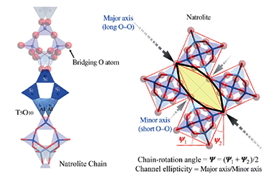Home > Press > Using pressure to swell pores, not crush them
 |
Abstract:
More than a decade ago, Thomas Vogt and Yongjae Lee, then colleagues at Brookhaven National Laboratory, uncovered a counter-intuitive property of zeolites. When they put these porous minerals in water, and then put the water under high pressure, the tiny cavities within the zeolites actually grew in size.
Using pressure to swell pores, not crush them
Columbia, SC | Posted on July 17th, 2013Pressure failed to crush, and even caused expansion. In the years since, Vogt and Lee, now at the University of South Carolina and Yonsei University (Seoul), respectively, have followed up with cation exchange experiments, placing a series of alkali metal ions into the pores of the aluminosilicate zeolites, particularly focusing on natrolite. X-ray diffraction studies, in collaboration with Chi-Chang Kao at Stanford University, have revealed the interior geometry of the cavities and the arrangement of the cations and water molecules held within, before and after pressurization.
The team has just published a detailed characterization of Li+, Na+, K+, Rb+ and Cs+ natrolites, the first four of which, when treated under pressure in water, become "super-hydrated" with water molecules - that is, the process inserts more water molecules into the zeolites than are present under ambient conditions.
The water molecules and ions together adjust the surrounding aluminosilicate framework. The team likens the shift in structure under pressure to what you see when you shift a "chatterbox," the children's fortune teller constructed from paper. The pressure-induced hydration can cause dramatic unit cell volume increases: more than a 20 percent expansion in Li-natrolite, for example.
The phenomenon is more than just an academic curiosity. The team is pursuing a number of applications in which a "tuned" cavity size that is triggered by pressure could be useful. Selectively - and irreversibly - trapping radioactive cations in a nuclear waste stream, for example, is just one area in which they've already demonstrated progress.
Lee, Kao and Vogt are supported by a Global Research Laboratory from the Ministry of Education, Science and Technology (MEST) of Korea.
####
For more information, please click here
Contacts:
Steven Powell
803-777-1923
Copyright © University of South Carolina
If you have a comment, please Contact us.Issuers of news releases, not 7th Wave, Inc. or Nanotechnology Now, are solely responsible for the accuracy of the content.
| Related News Press |
News and information
![]() Researchers develop molecular qubits that communicate at telecom frequencies October 3rd, 2025
Researchers develop molecular qubits that communicate at telecom frequencies October 3rd, 2025
![]() Next-generation quantum communication October 3rd, 2025
Next-generation quantum communication October 3rd, 2025
![]() "Nanoreactor" cage uses visible light for catalytic and ultra-selective cross-cycloadditions October 3rd, 2025
"Nanoreactor" cage uses visible light for catalytic and ultra-selective cross-cycloadditions October 3rd, 2025
![]() Researchers tackle the memory bottleneck stalling quantum computing October 3rd, 2025
Researchers tackle the memory bottleneck stalling quantum computing October 3rd, 2025
Chemistry
![]() "Nanoreactor" cage uses visible light for catalytic and ultra-selective cross-cycloadditions October 3rd, 2025
"Nanoreactor" cage uses visible light for catalytic and ultra-selective cross-cycloadditions October 3rd, 2025
![]() Cambridge chemists discover simple way to build bigger molecules – one carbon at a time June 6th, 2025
Cambridge chemists discover simple way to build bigger molecules – one carbon at a time June 6th, 2025
Govt.-Legislation/Regulation/Funding/Policy
![]() New imaging approach transforms study of bacterial biofilms August 8th, 2025
New imaging approach transforms study of bacterial biofilms August 8th, 2025
![]() Electrifying results shed light on graphene foam as a potential material for lab grown cartilage June 6th, 2025
Electrifying results shed light on graphene foam as a potential material for lab grown cartilage June 6th, 2025
![]() Institute for Nanoscience hosts annual proposal planning meeting May 16th, 2025
Institute for Nanoscience hosts annual proposal planning meeting May 16th, 2025
Discoveries
![]() Researchers develop molecular qubits that communicate at telecom frequencies October 3rd, 2025
Researchers develop molecular qubits that communicate at telecom frequencies October 3rd, 2025
![]() Next-generation quantum communication October 3rd, 2025
Next-generation quantum communication October 3rd, 2025
![]() "Nanoreactor" cage uses visible light for catalytic and ultra-selective cross-cycloadditions October 3rd, 2025
"Nanoreactor" cage uses visible light for catalytic and ultra-selective cross-cycloadditions October 3rd, 2025
Announcements
![]() Rice membrane extracts lithium from brines with greater speed, less waste October 3rd, 2025
Rice membrane extracts lithium from brines with greater speed, less waste October 3rd, 2025
![]() Researchers develop molecular qubits that communicate at telecom frequencies October 3rd, 2025
Researchers develop molecular qubits that communicate at telecom frequencies October 3rd, 2025
![]() Next-generation quantum communication October 3rd, 2025
Next-generation quantum communication October 3rd, 2025
![]() "Nanoreactor" cage uses visible light for catalytic and ultra-selective cross-cycloadditions October 3rd, 2025
"Nanoreactor" cage uses visible light for catalytic and ultra-selective cross-cycloadditions October 3rd, 2025
Research partnerships
![]() Lab to industry: InSe wafer-scale breakthrough for future electronics August 8th, 2025
Lab to industry: InSe wafer-scale breakthrough for future electronics August 8th, 2025
![]() HKU physicists uncover hidden order in the quantum world through deconfined quantum critical points April 25th, 2025
HKU physicists uncover hidden order in the quantum world through deconfined quantum critical points April 25th, 2025
|
|
||
|
|
||
| The latest news from around the world, FREE | ||
|
|
||
|
|
||
| Premium Products | ||
|
|
||
|
Only the news you want to read!
Learn More |
||
|
|
||
|
Full-service, expert consulting
Learn More |
||
|
|
||








